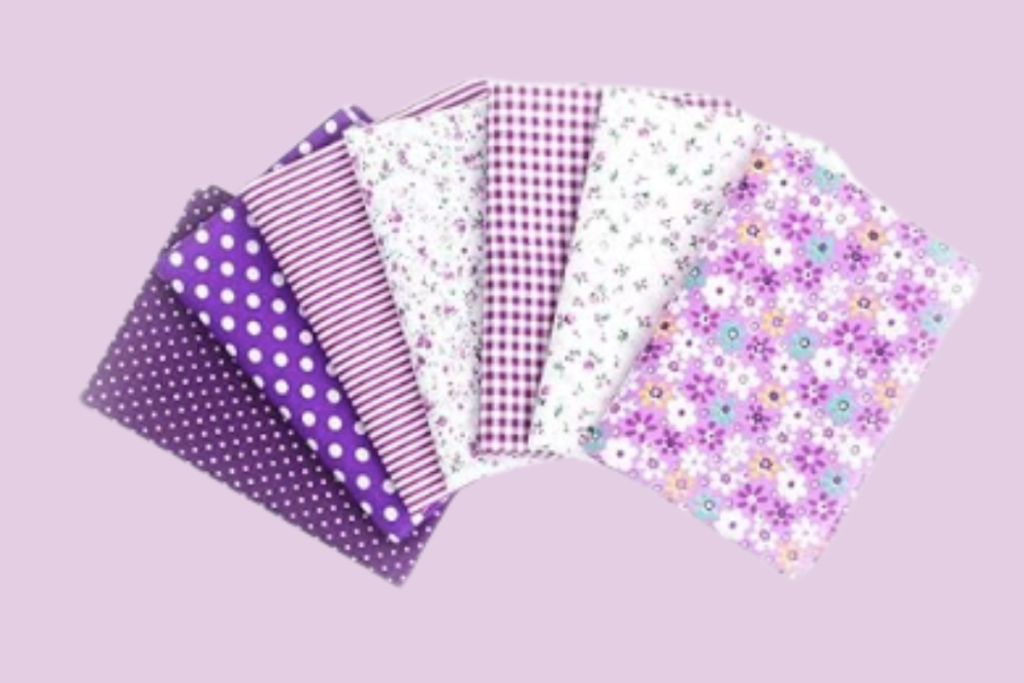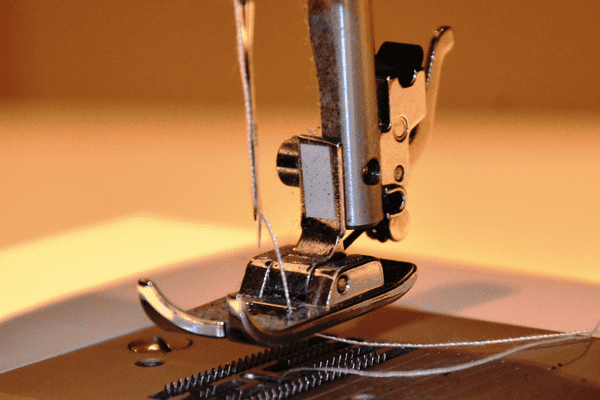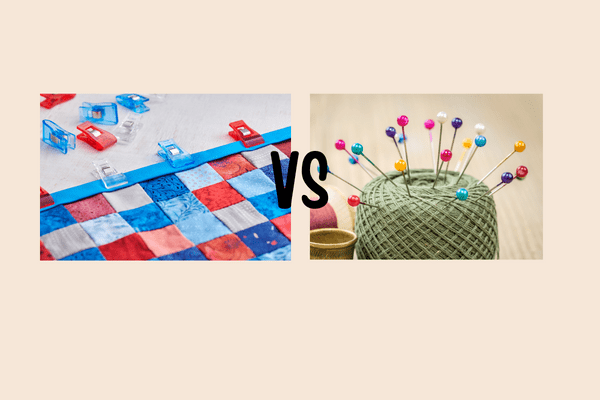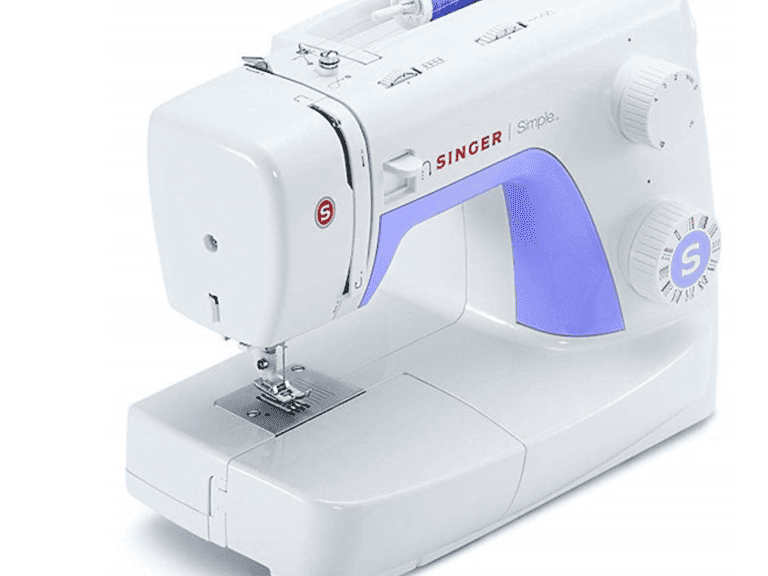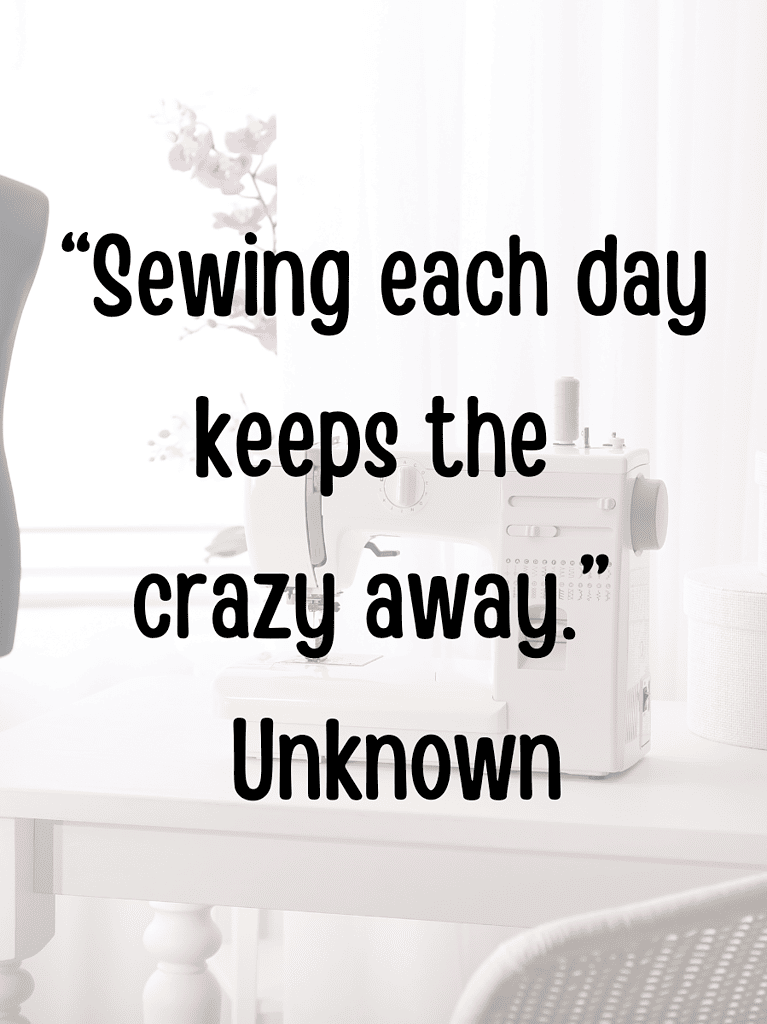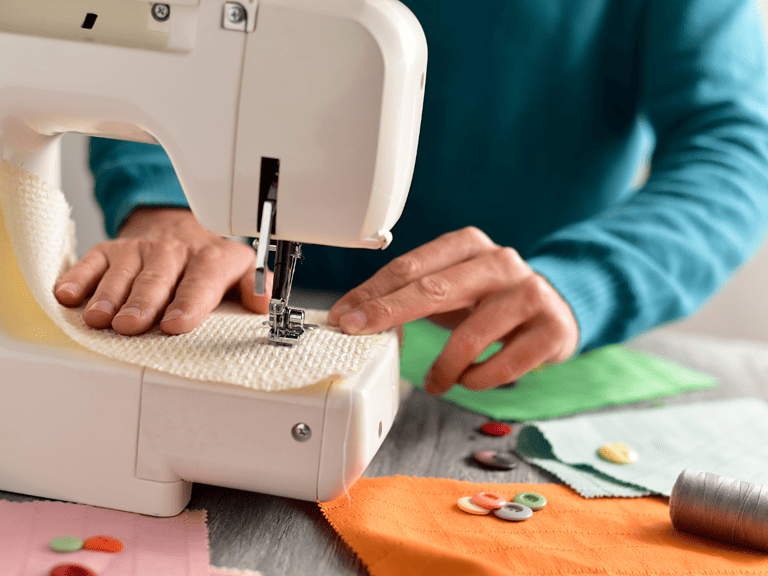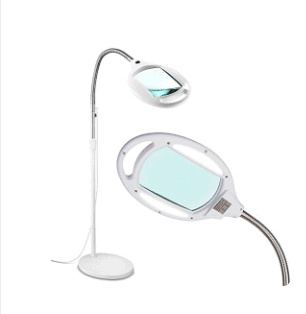Sewing Needle Size Chart: Download for Free Now
Have you ever tried to sew a project and your needle broke or bent? If so, you probably didn’t have the right needle. We have created a free sewing needle size chart for you to ensure that, depending on the type of fabric in your sewing project, you are using the appropriate needle type.
Your machine most likely came with at least one needle and more than likely a few universal needles, but depending on your project, the type of needle you need will be different.
Let’s dive in today to the different types of needles and a little bit about why they are numbered the way they are. Don’t forget to download the sewing needle size chart below
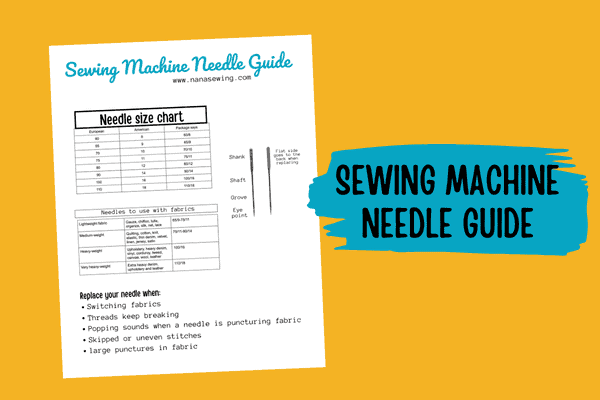
Table of Contents
Sewing needle types
I will never forget Ms. Jackson, our Home EC Teacher, teaching us about sewing needles. She gave us some cut-up old jeans and had us sew using a universal needle and within seconds, our needles bent.
I was shocked at how the needle bent in half, but it taught me that it matters what kind of needle you use. I can’t teach you like Ms. Jackson, but I can help you with a sewing needle size chart.
How do I know which Needle to Use for Sewing?
Glad you asked. There are 3 things to consider when selecting a needle. Size, Material, and the Point. You will typically find this information on the needle packaging, but if not, simply refer to the sewing needle size chart.
Size:: The size of a needle is determined by its diameter in millimeters (mm) and is written with two numbers. For example, a 70/10 needle is 0.7 mm in diameter. It has 2 numbers because the first is the European size while the second is the American size.
Fabric type: Depending on the fabric you are using for your project will determine which needle you use. For example, woven fabrics use a universal needle while knit fabrics call for a ballpoint or jersey needle.
Point: If you are shopping for needles, you will find there are five main needle points available; Universal, Sharp, Ballpoint, Stretch, and Jeans/Denim. Each point is made specifically to go through your fabric without crushing the threads.
What Are the Most Commonly Used Needle?
For most sewing projects, you will use a universal needle. If you are using woven fabrics such as cotton or linen, this is the needle you will choose.
Another common needle you will use often are ball point needles. This needle is used for knits and lightweight fabrics like jersey.
Finally, you might need to use a stretch needle. Stretch needles were created so that the eye of the needle doesn’t break the fibers of delicate stretchy fabrics.
Don’t worry about trying to remember all of these. We have them on the sewing needle size chart along with other helpful information.

What needle is Best for General Sewing?
With most home machines, you receive a Universal needle with your machine. You will use this needle the most. If you are using cotton fabric like most of us do, this is the perfect needle for your sewing project.
What is the Most Commonly Used Sewing Needle Size?
The most commonly used needle numbers are 70/10 and 80/12. Your 70/10 needle is usually used for lightweight fabrics such as chiffon, organza, and most lace, while the 80/12 is better suited for medium-weight fabrics like cotton and linen.
Are sewing needles magnetic?
Although they aren’t magnetic, they are ferro-magnetic meaning they are attracted to magnets, which makes it so much easier to place in your machine.
Can I sharpen my sewing machine needles?
You can’t sharpen them, so you will want to keep an extra package on hand, as we will talk in a few minutes about how often you should change your needle. The sewing needle size chart also has suggestions to remind you when a needle needs changed.
What are the sewing needle parts?
We included an illustration of this on our sewing needle size chart, so you can see each part.
- The butt-this is the part that inserts into your sewing machine.
- The shank – this is where you’ll find the needle size. When you insert your needle into your sewing machine, this part should be facing you and is more rounded.
- Flat side – located opposite of the shank. This side should be facing the back of the machine when inserting the needle into the sewing machine
- The shoulder – this is where on most needles you’ll find color codes for needle type and needle size.
- The shaft
- The eye – this is where you insert the thread, so you can sew
- The tip
- The point

What are the different Sewing needle types
Universal
As the name suggests, this is a very versatile needle. You will use it with woven fabric like cotton and linen and will use it for most of your projects. Your sewing machine probably came with this needle and possibly a few others.
It’s a good idea to have several of these on hand, as we will talk about how often you need to change your needle.
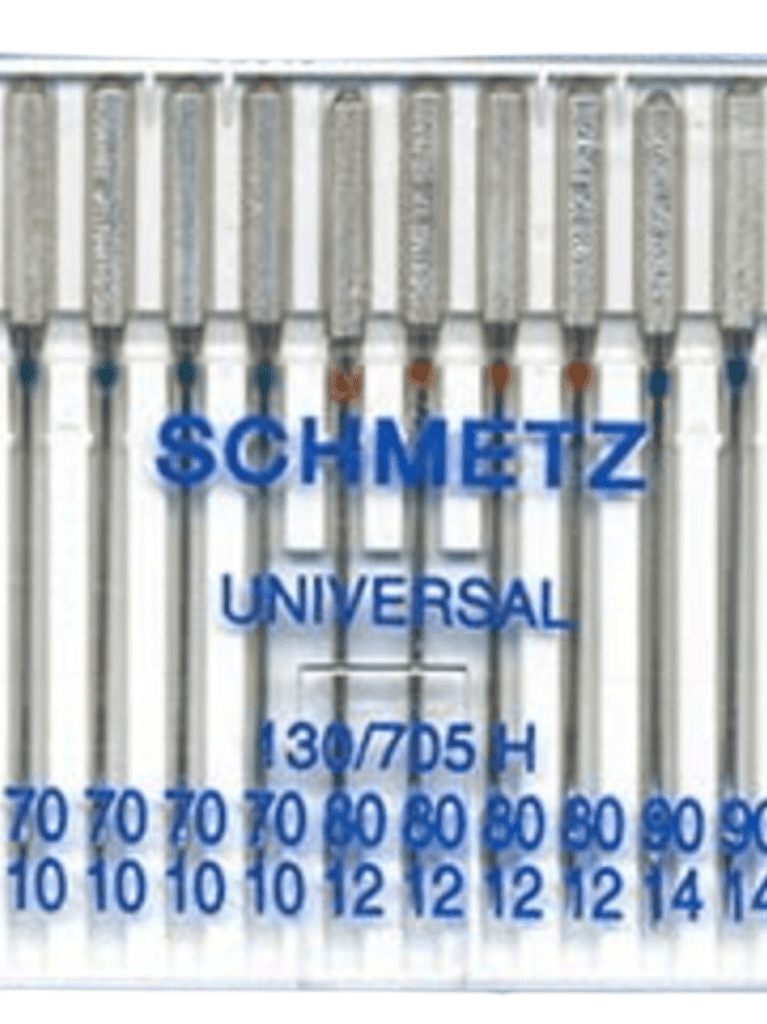
Ballpoint needle
This needle is used for fabrics such as cotton knits, interlock, rib knits, fleece, double knit, and most knit fabrics. You may also see it listed as a knit needle. It gets its name because the needle has a ballpoint, which keeps it from damaging the fibers of the material.
Jersey
This needle is used exclusively for jersey knits, so if you are making clothing with it, you will want to use this needle.
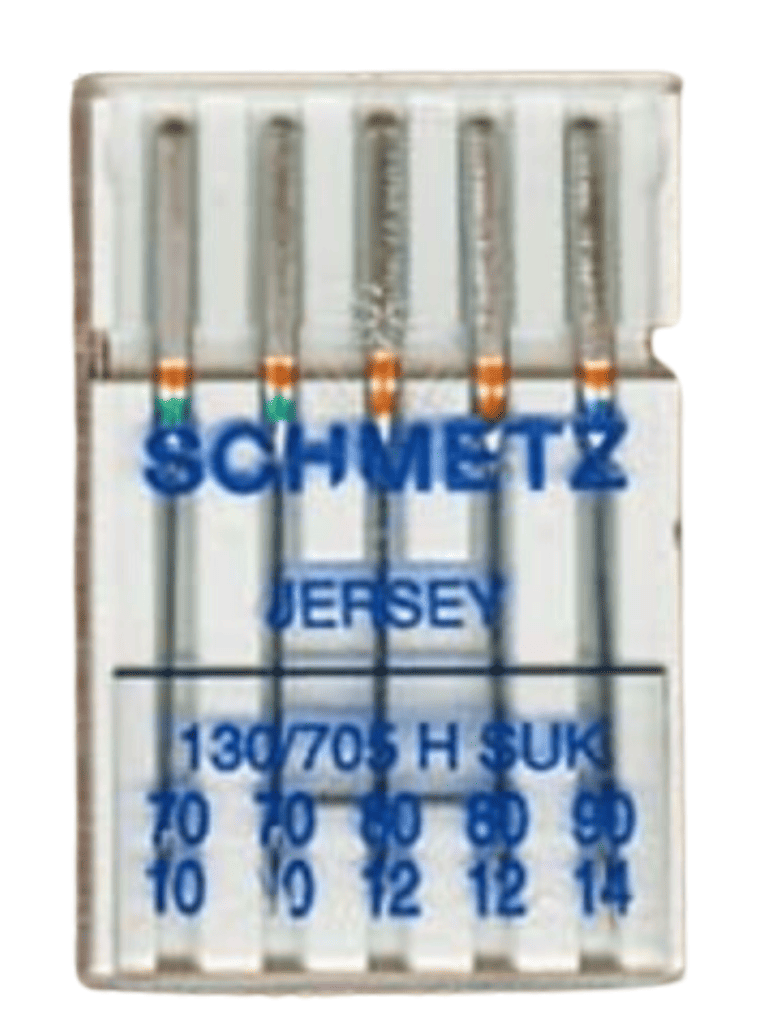
Stretch needles
As the name suggests, this is used for elastic fabrics.

Jeans
This needle is used for denim and canvas, but also as a quilting needle if you have several thick layers of fabric. Definitely heavyweight fabrics vs thin fabrics.
Microtex
This needle has a very sharp point and is used for lightweight material that needs sharp needles to pierce it so not to damage the fibers.
Leather needle
This needle is used on Leather and Vinyl materials. You will most definitely use this with heavier thread also on these fabrics
Twin Needles
This needle has 2 needles attached at the shaft. It’s used for making a double stitch, such as jeans or other garments.
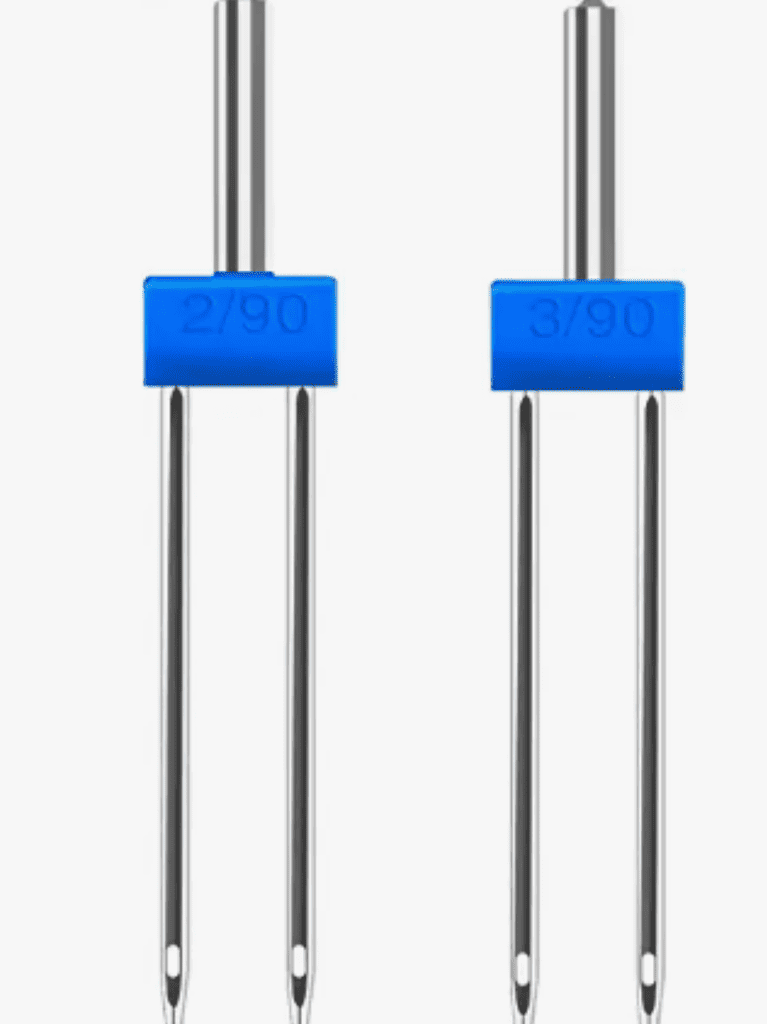
Other Specialty Needles
There are some other needles that you simply won’t use often unless you are working on a specific project. They are worth noting. They include: metallic needles, embroidery needles, quilting needles, tapestry needles (also known as darning needles), beading needles, chenille needles, hand sewing needles, topstitch, hemstitch, double eye, metallic twin, denim, twin stretch twin, gold embroidery and we can’t forget cross stitch needles)
What Sewing Needle do I use for fleece?
You can use a universal needle, sharp or ballpoint needle. The sharp point will help penetrate the fabric, while the slightly rounded tip of a ballpoint needle will slip between the threads rather than cutting them. Use whichever needle you have on hand.
What do the bands of color mean?
I think they put a color on needles because a woman ended up with several needles and couldn’t figure out which one was which. Thus, now the colors help you know which needle you are looking at and for. Don’t forget to download the sewing needle size chart to have all of this information.
- Universal – no color code
- Ballpoints – medium blue
- Jersey – orange or light brown
- Stretch – Yellow
- Jeans – dark blue
- Microtex or sharp points – purple
- Leather – brown
- Universal twin – red shaft
- Stretch twin – blue shaft
What are the needle sizes and what do they mean?
The size of the needle matters. If you choose the incorrect size, it can lead to poor stitch quality. We know it can seem confusing if you are just beginning, but let’s make it simple.
At the top you have a band of color and you know from right above which type of needle that is and then at the bottom there are 2 numbers. This is the size of your needle.
Each needle has 2 numbers. Here’s an example: 70/10 or 80/12. In the sizing system the higher number is the European number and is the second is the American size.
European sizes will range from 60 to 130, 60 being a fine needle and 130 being a thick heavy needle. The American system uses 8 to 21, with the lower number 8 being the finest needle and 21 being a thick heavy needle. Make sense?
Sewing Machine Needle Sizes:
- 60/8
- 65/9
- 70/10
- 75/11
- 80/12
- 90/14
- 100/16
- 110/18
- 120/19
- 125/20
- 130/21
Do I need to use the right sewing machine needle?
The answer is yes. I sewed our Hobo bag the other day and honestly didn’t feel like changing the needle, and you can see in the video what that did when I used a Universal needle on heavy fabrics like denim. I should have used a new needle, specifically denim needles.
A few things that will happen if you use the wrong size of needle:
- needle breakage or bent needle
- stuck needle and thread in the feed dogs, which is such a pain to fix
- skipped or uneven stitches, which will require your seam ripper
- puckered or damaged fabric which can’t be fixed
- weird sounds in your sewing machine, like something is about to break or get stuck.
Don’t forget to download the sewing needle size chart below.
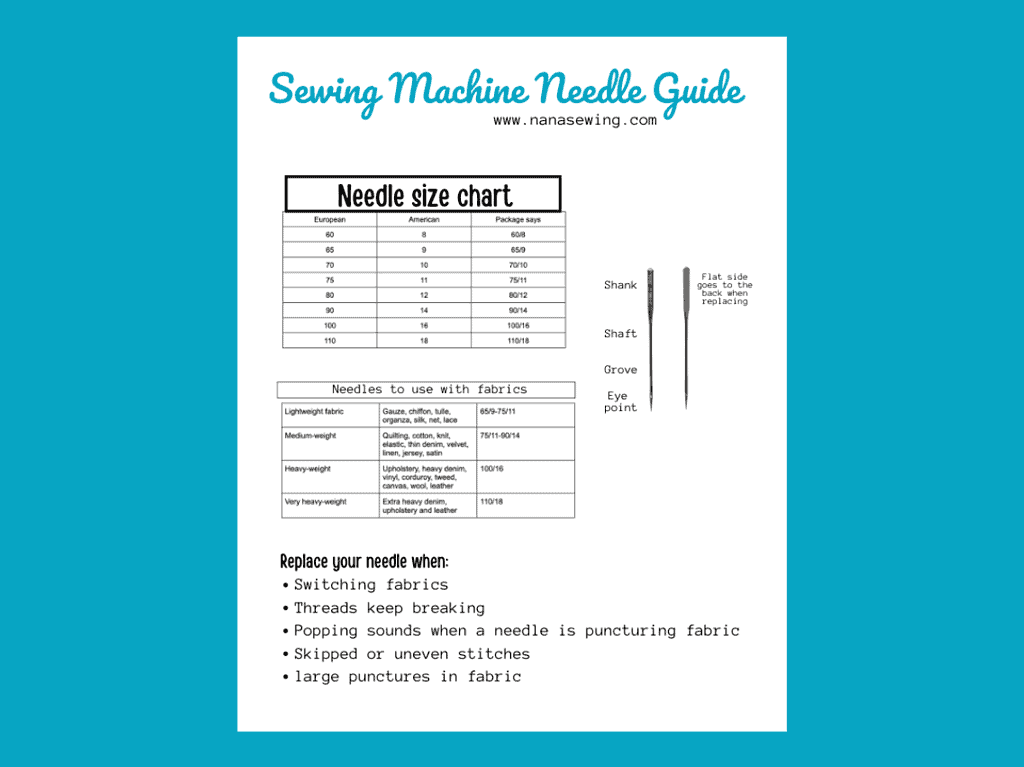
When should you change your sewing machine needle?
Every time you start a new project, you should change your needle. You should also change it after 8–10 hours of continual sewing. We give some great reminders on the Sewing Needle size chart above
Which brand is the best when it comes to sewing needles?
The 2 most commonly used sewing needles are Singer and Schmetz needles. It really is a personal preference. I have noticed that when I use Schmetz needles, I get a little more than 10 hours out of the needle. They make a very good needle. I always have a pack of needles from them in my sewing drawer.
I hope now you are confident in knowing the best needle for your project and know more about the different needle sizes.
Don’t forget to download our free sewing needle size chart to make sure you always have the correct needle size for your project.
Other Sewing Resources:
If you are new to sewing, we recommend that you start by learning the basics and starting with a simple project like the potholder.
Start with:
Sewing Needle Size Chart PDF

Fabric Giveaway
Enter our monthly fabric giveaway. Simply complete the tasks daily and you will be entered into the drawing. Winner will be randomly drawn on the first day of the month and notified via email
